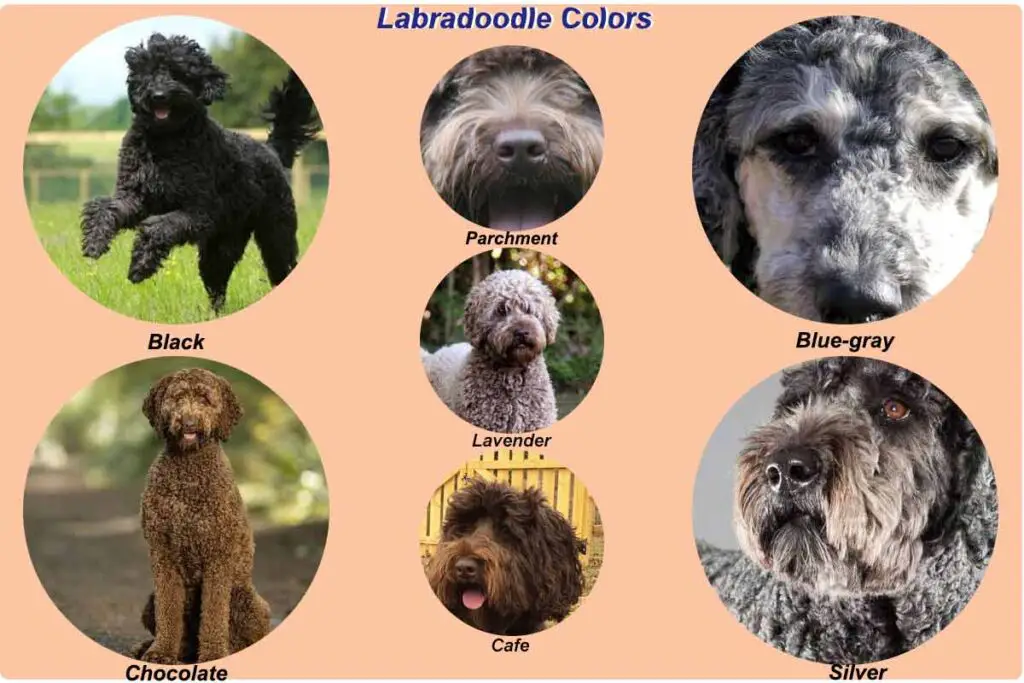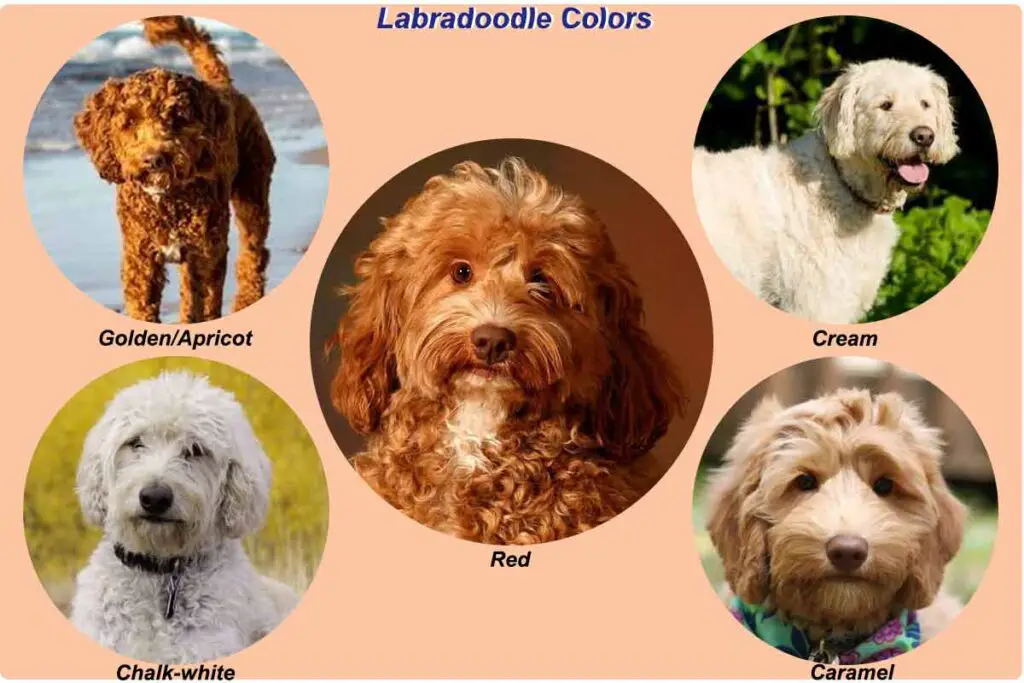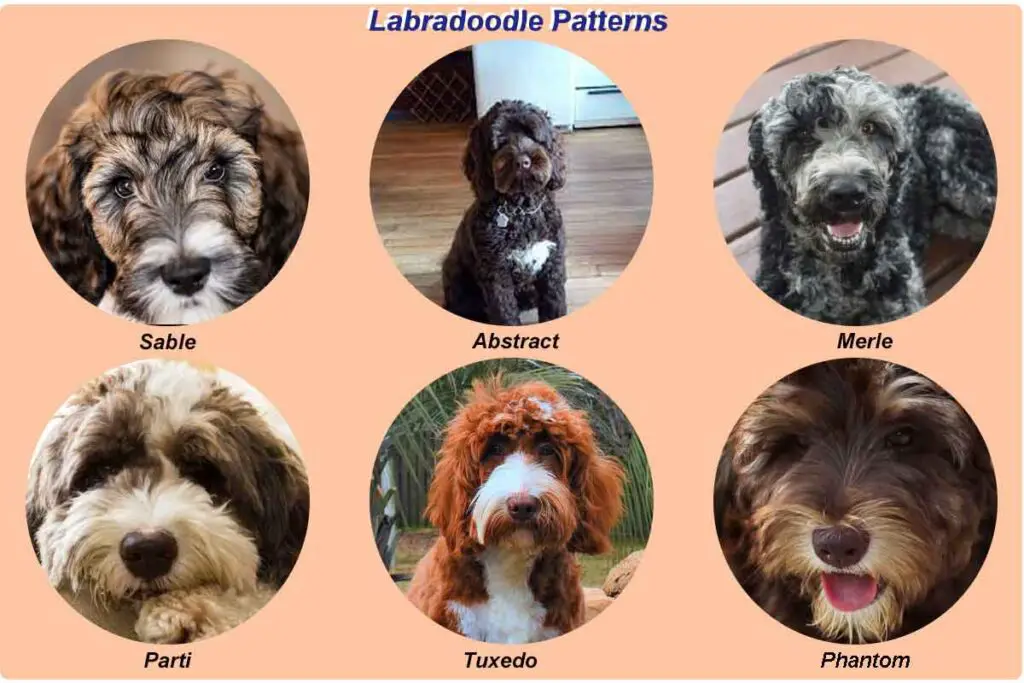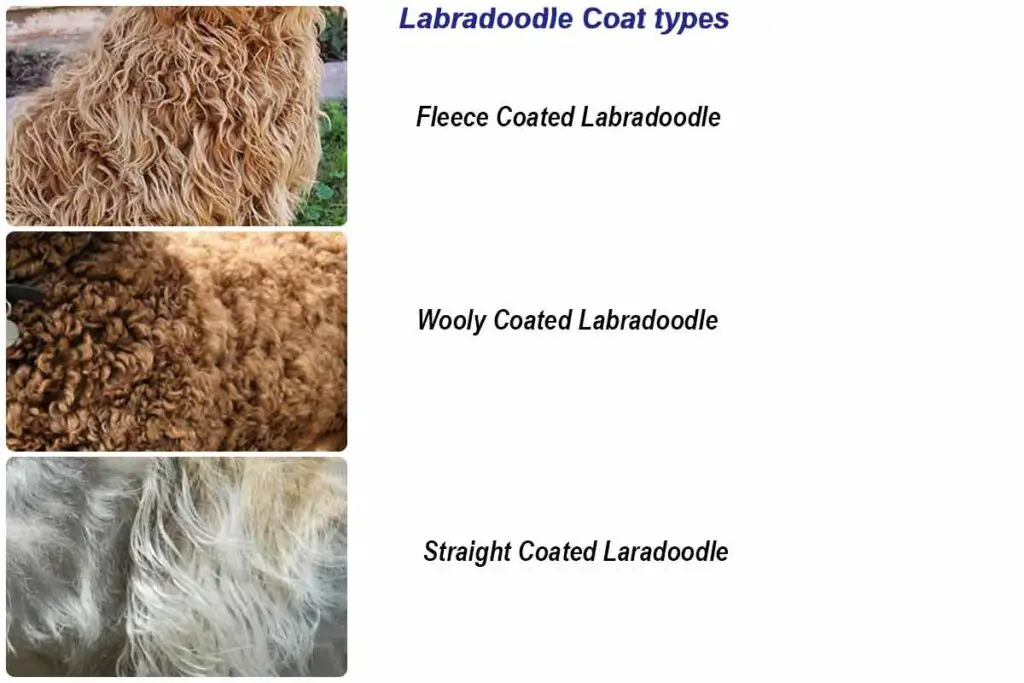Labradoodles come in a variety of colors and coat types to choose from. This comes down to the traits inherited from the parents as each puppy will be different from the other. The coat color can also change in the course of a pup’s lifetime and thus you cannot be certain that the pup’s color will be retained into adulthood. Sun bleaching can also cause color changes as the dog gets older.
The standard Labradoodle colors are;
- Gold
- Cream
- White
- Black
- Caramel
- Apricot
- Parchment
- Chalk
Rare colors are;
- Parti
- Phantom
- Merle
- Tuxedo
- Sable
- Silver
- Café
- Blue
- Parchment
- Red
- Lavender
- Chocolate
The color and coat type will not affect the dog’s personality.
As a mixed dog, you cannot predict which color the puppy will be as both parent breeds come in a variety of colors. But for the most part, Labradoodles are solid-colored but others will be a combination of colors. No matter what color your Lab Poodle mix inherits, you can count on him to be loyal, friendly, outgoing, and family-oriented as color does not affect the dog’s personality.
About Labradoodle Colors
Genetics determine a Labradoodle’s color. Genes contain the codes for the color traits and come in pairs, each gene (allele) from one parent. The alleles are located in specific sites on the chromosome known as the locus.
This will sound quite confusing if you have no genetic background, so bear with me.
Melanin is the color pigment that determines the body and coat color. There are 2 types of melanin pigment that form the basis for a variety of color shades that are;
- Eumelanin is default black but variations also occur depending on the distribution and dilution of the pigment to create colors such as blue-grey, and liver (brown) that the entire coat emulates. It is also responsible for black noses and brown eye colors. If Eumelanin is not produced in the nose, it ends up pink and the eyes blue.
- Phaeomelanin is primarily yellow or red and its shades such as gold, deep red, cream, orange, and tan depend on the genes that control the color intensity. It is only visible on hair color and not eye and nose color.
Color genes;
K locus (Dominant black):
This is where the dominant black gene (K) is located and is responsible for the default black coat (eumelanin).
The K locus consists of 3 alleles;
- Dominant K- Produces black. Black is dominant and a dog with a capital K will have a solid black or chocolate coat. The nose will be black with eyes that are almost always brown. The dominant black gene (Kb) is dominant over the A-locus but can be modified by brown, dilution, greying, and merle genes. These genes alter the shade of the black pigment but cannot add red pigments to the coat or skin. Any Labradoodle with dominant K may be genetically red or sable but they won’t be expressed due to the dominance of the gene. Red pigments can only be added to the coat through the recessive red gen on the E-locus (e/e). The coat will be turned solid red but retain a black nose if the E-locus is e/e.
- Kbr– Produces brindle pattern. 2 copies are required for a brindle coat (kbr/kbr). This gene is dominant over small k but recessive over Kb.
- Recessive k– Non-black and allows black, red, and tan markings to show but with a black nose. 2 copies of these alleles should be present for red marking to show. How these red markings show is determined by the A locus.
When other genes interact with the K locus, other shades such as liver, blue, grey, and silver come about.
A locus (Agouti):
This is the location of the Agouti (ASIP) gene that affects whether eumelanin or phaeomelanin is produced, distribution, and specific patterns.
In its dominant form (A), the gene promotes the production of red pigments (phaeomelanin). But the recessive mutant variant (a) promotes eumelanin production when 2 copies of the recessive allele are present for a black coat.
However, the A-locus can only shine through if the doodle has a pair of recessive k alleles (k/k). when the dog has a dominant K gene, the genes on the A-locus though present will not show.
There are 4 known variants of this gene;
- Ay– The dog will have a fawn color (yellowish tan). This allele is dominant over others in the gene and their presence will not matter
- aw– Switches between eumelanin and phaeomelanin as the hair grows for a sable coat (wolf sable gray). 2 copies of the gene (aw/aw) are required for the color to be expressed.
- at– Produces tan markings. The dog will be tan or black or tricolor
- a– Produces a solid black coat. a/a will have a black coat
Locus E and K affect the expression of the A locus. In the presence of e/e genotype and K allele, the A locus is not expressed.
E locus (Extension):
This locus affects all non-agouti eumelanin and phaeomelanin distribution and patterns. It determines which area of the coat produces eumelanin and which produces phaeomelanin.
In its dominant form (E), the gene allows for the expression of the K, B, and A-locus for eumelanin production. However, with 2 copies of the recessive variant (e/e), the coat will be completely red (or red shades such as yellow, apricot, cream, etc) as it only promotes the production of phaeomelanin. It is genetically impossible for a red dog to have a black or brown coat but will not affect the skin, eye, and nose color
The recessive red (e/e) dominates all other loci except for white.
B Locus (Brown):
This locus contains the gene that modifies eumelanin only to produce a liver (rich brown) color. the gene is recessive and thus b is brown/liver/chocolate while capital B (Dominant) is non-liver. 2 copies of b (b/b) are required to modify black to brown.
All black hair will be tuned to brown as it is genetically impossible for the doodle to have any black hair. The nose will be brown or pinkish (rose), the paw pads brown, and the eyes amber.
Some Labradoodles can be born with a red coat (e/e) but still, be genetically brown if the nose is brown or rose. This is because the brown gene does not affect phaeomelanin pigments.
G Locus (Greying):
This is the home of the greying gene in Labradoodles. It affects how intense the eumelanin pigments are over time.
The greying gene is dominant (G) and only affects the black pigments on the coat. Only one copy of the gene is required for progressive greying to occur as the dog ages.
The gene does not affect the nose or eye color but the black or brown coat will lighten as the pup gets older.
M Locus (Merle):
This site creates coats of random irregular-shaped patches of lighter diluted and solid color. It only dilutes eumelanin pigment (black) and thus black, liver, blue, or isabella. It is not safe to breed two merle dogs as it increases the risk of eye and ear defects
S locus (White spotting):
This site is involved with the distribution of white on the coat to create random and asymmetrical patterns such as parti. The spotting patterns can appear in any coat color either with eumelanin or phaeomelanin pigments causing some parts of the coat to be white as no pigments are produced in those sections. Rarely is the entire coat affected.
There are 4 variants of the S allele;
- S– solid color with no white pigmentation
- si– White spots- often seen on the collar, legs, and belly
- sw– extreme white spotting due to a lack of or production of less pigment
- sp-piebald– Produces irregular white spotting depending on the number of mutant alleles
Black Pigment color shades
Black pigment dogs must have dark brown eyes. Depending on the number of eumelanin produced and distributed to the hair shaft will give you different shades that include;
- Chocolate
- Blue
- Silver
- Lavender
- Cafe
- Parchment
| Colors | Description |
| Black Labradoodle | The entire coat should be solid black with no markings. Some may develop a Bluish, charcoal, or silver hue as they age Eyes: Dark brown Nose: Black Paw pads, lip, and eye rims: Black Nails: Black |
| Chocolate/Brown/Liver Labradoodle | Are born almost black and develop a rich and even brown coat with no markings. Eyes: Dark amber to pale hazel-green Nose: Rose, brown, or liver Paw pads, lip, and eye rims: Liver or brown Nails: Dark brown |
| Blue-gray Labradoodle | Are born almost black and develop a dark to smoky blue-gray coat as they age over 1 to 3 years. Tends to appear as Multi-colored and is rarely a solid color Eyes: Dark brown Nose: Blue-gray Paw pads, lip, and eye rims: Dark brown Nails: Black |
| Silver Labradoodle | Are born dark chocolate and lighten or fade into a silver-grey or light-grey color in 1-3 years A solid color is preferred but it’s common for them to be uneven Eyes: Dark amber to pale hazel-green Nose: Rose, brown Paw pads, lip, and eye rims: Dark brown Nails: Dark brown |
| Lavender Labradoodle | Born chocolate and develop a smoky lavender coat that may have a pinkish hue (a shade of lilac) Eyes: Amber to pale hazel green Nose: Rose Paw pads, lip, and eye rims: Pinkish-lilac to pale purple Nails: Dark brown |
| Cafe Labradoodle | Born chocolate and take 1 to 3 years to develop a milky-chocolate color Can be a combination or one solid color Eyes: Amber to pale hazel green Nose: Rose or brown Paw pads, lip, and eye rims: Brown Nails: Dark brown |
| Parchment Labradoodle | Are born light chocolate and fade into a creamy beige chocolate color similar to a milky cup of coffee as early as 6 weeks Should be an even color but can have a two-tonal appearance and darker markings around the ears and face Eyes: Dark amber to pale hazel-green Nose: Rose or brown Paw pads, lip, and eye rims: Brown Nails: Dark brown |

Red or Yellow color shades
In mammals including dogs, phaeomelanin bestows yellow and red to the hair shafts and the intensity or shade of the color will depend on the number of pigments distributed in the hairs. Other shades include g
- Gold
- Cream
- Caramel
- Chalk
Their main difference is their nose color.
| Colors | Description |
| Red Labradoodle | Ranges from light to a rich dark red but can fade and tan over time The entire coat should be red and even from the base to the tip with no markings Eyes: Dark brown Nose: Black Paw pads, lip, and eye rims: Black Nails: Black |
| Cream Labradoodle | Is a shade that appears darker than white. It comes in various shades ranging from a light to a deep cream color that is almost red Labradoodles with brown noses are referred to as caramel cream Appear on multi-colored Labradoodles with gold and apricot markings on the paws and face Eyes: Various shades of brown Nose: Dark brown or rose Paw pads, lip, and eye rims: Black Nails: Light nails |
| Caramel Labradoodle | Is a rich shade of cream Should be a consistent color but may have hints throughout the coat Eyes: Hazel to amber Nose: Dark brown or rose Paw pads, lip, and eye rims: Liver or brown Nails: Dark brown |
| Apricot or Golden Labradoodle | Rich dark cream Color resembling the inside of apricot to dark gold Darker on the ears Should be a consistent coloration that may darken or lighten over time Eyes: Dark brown to hazel-green eyes Nose: Black or brown Paw pads, lip, and eye rims: Black Nails: Black |
| Chalk Labradoodle | Appears creamier or darker when put against a white backdrop more like chalk Others may have deeper chalk-white facial markings Eyes: Dark brown to hazel-green eyes Nose: Black or rose Paw pads, lip, and eye rims: Black or rose Nails: Black or light |

Coat patterns
| Patterns | Description |
| Solid color | Only one single color of any color with no markings |
| Tuxedo Labradoodle | Are part black and part white Has distinct white markings on the legs, chest, tummy, forehead, nose |
| Parti Labradoodle | Is made up of 2 colors- 50% white and part another shade of any color but most are apricot or brown. Some may have blue, red, or silver patches The predominant color is the same for the eye and lip rims, nose and eye color Has white on the face and head |
| Sable Labradoodle | Are born black and fade with age into a lighter creamish or whitish shade Some of the body parts remain black with spots on the ears and other parts of the body The base of the hair shafts are lighter with darker tips The distribution of the darker tips can be even or uneven |
| Phantom Labradoodle | They have a solid base color such as black or brown sporting particular sharply defined markings of any second color such as white, silver, gold, or cream The markings appear above the faces, eyes, faces, paws, throat, below the chest, below the tail, the paws and legs, and the side of the muzzle Common combinations are; – Black and gold – Black and cream – Silver and brown – Cream and brown Some are a 3-color combination The nose can be black or rosy |
| Merle Labradoodle | This is a rare and unique combination of irregular patches of black, red or chocolate, apricot, blue-gray, silver, and cream on a solid base color Most Merle Labradoodles are not 100% Labradoodle but Australian Labradoodles (Aussiedoodle) These dogs have blue, green, or dark-colored eyes |
| Abstract Labradoodle | Abstract Labradoodles are a combination of colors, with less than 50% white with no particular pattern. The rest of the body can be any other color The nose color should be rosy, black, or brown, matching the base color. The eyes can be blue, black, or brown. |

Labradoodle coat types
Labradoodles also come in a variety of coat lengths and textures that include;
- Shaggy or Loose Curl coat
- Curly coat
- Straight or hair coat
The coat may change in some doodles from puppyhood to adulthood due to hormonal changes.
| Coat type | Description | Genotype |
| Fleece coated Labradoodles | This is the most common coat type preferred for the low shedding properties and ease of grooming. The coat is wavy to slightly silky with loose shaggy and soft curls | N/C |
| Wooly or Curly coats | This coat is thick, soft, curly, and dense similar to sheep’s wool. Loose spirals are desired but a spring appearance is also acceptable It varies from tight to loose curls and shed the least Is the 2nd most common coat type | C/C |
| Straight or hair-coated Labradoodles | Hair coats are straight resembling a Labrador’s scruffy appearance but vary in thickness and length Has a light to moderate shedding | N/N |

To Sum up
There are a variety of Labradoodle color and coat variations inherited from the Labrador and Poodle parents.
Some dogs may have top coat bleaching and discoloration due to sun exposure (sunning).
Solid-colored pooches are preferred but marking such as Parti, sable, and phantom are accepted but not preferred. Some of the solid colors include black, chocolate, silver, red, caramel, cream, and so on.
All in all, no color is superior to the other and you should not base your buying decisions on color alone.
There you go, WOOF!
